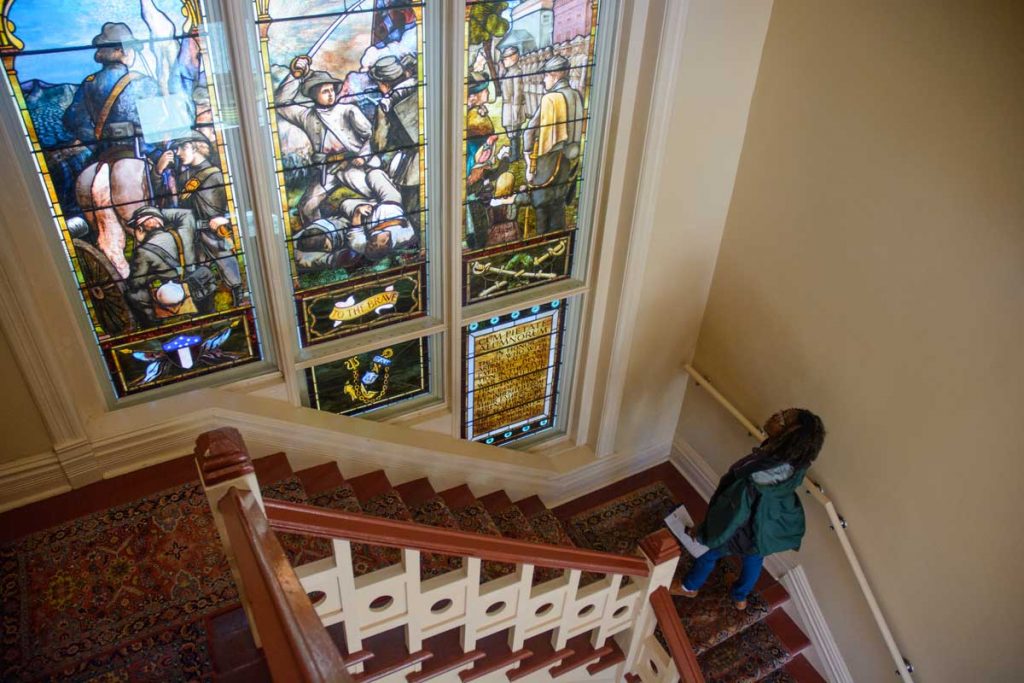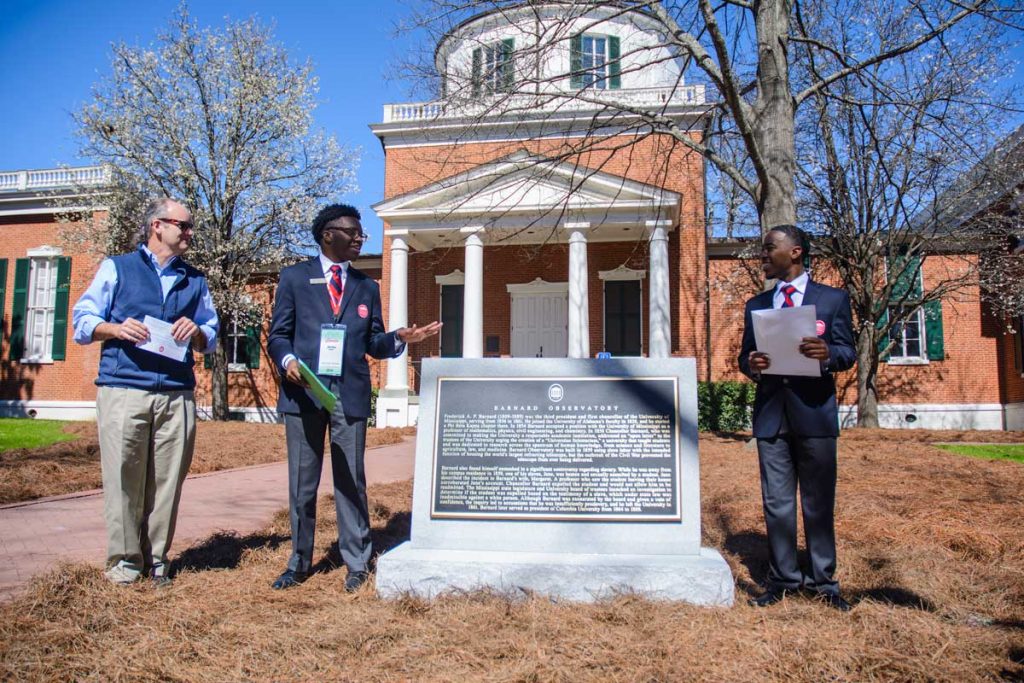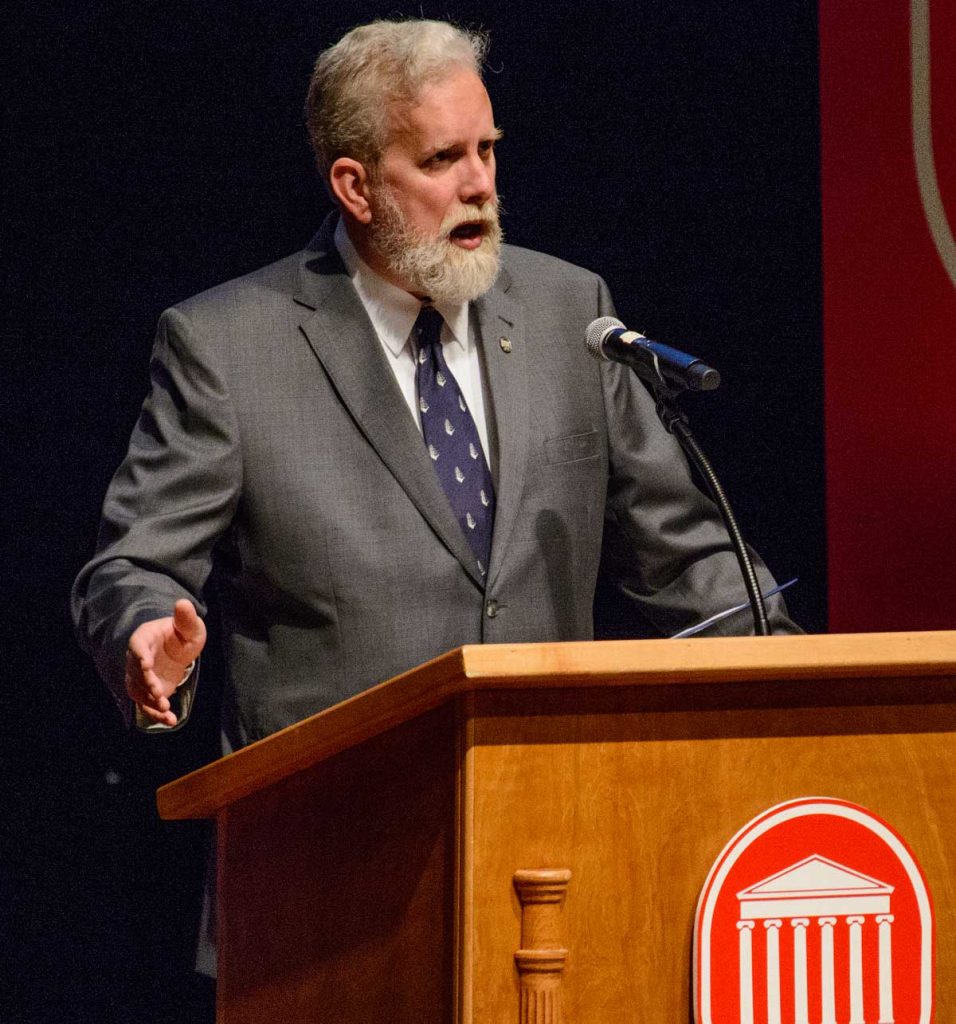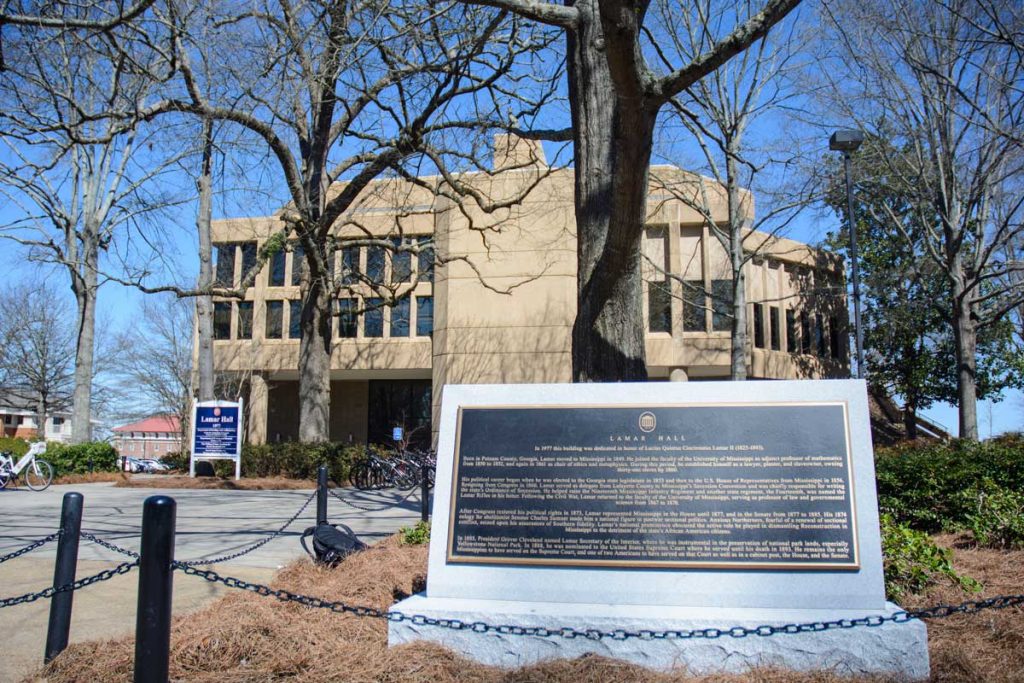The University of Mississippi is known for its tumultuous past, but today that history, both good and bad, was etched in bronze.
Students, faculty and members of the Oxford community gathered in the Gertrude C. Ford Center for the Performing Arts to commemorate the unveiling of the six newest contextualization plaques around campus.

Kathy Thompson looks at the Tiffany stained glass window in Ventress Hall, one of the six locations a new contextualization plaque was placed Friday. (Photo by Marlee Crawford)
Chancellor Jeffrey S. Vitter, who founded the Chancellor’s Advisory Committee on History and Context in the summer of 2016, which made these plaques a reality, delivered the welcome address.
“As Mississippi’s flagship university, we have long been committed to honest and open dialogue,” Vitter said. “The work of CACHC represents that commitment in action. It can be challenging to tell the story of change and transformation while we are going through it, but we are here today to recognize that this work indeed is a significant moment of change and transformation in the life of our university.”
The locations of the new markers and plaques include Longstreet Hall, George Hall, Lamar Hall, Barnard Observatory, the Tiffany stained glass window in Ventress Hall, as well as a plaque between Ventress and Croft Hall on the Circle noting the contributions of enslaved laborers.
“These plaques are daily reminders of our obligation to learn from the past and commit to an inclusive future,” Vitter said.
The keynote address was made by John R. Neff, a member of the context committee and director of the university’s Center for Civil War Research, evoking the metaphor of a crossroads.
“Today we take a step in our long journey, passing through yet another crossroads together,” Neff said. “We take a bold step today in the right direction. A step taken not for ourselves alone, but also for all who come after us.”
He explained the significance of crossroads in global culture and in Mississippi, referencing the legend of Robert Johnson, who sold his soul to the devil in exchange for making him a master of guitar and the blues.
“Crossroads have come to represent many things for many people, but for today, simply think of crossroads as points of decision,” Neff said. “At a crossroads, do you forge ahead? Do you turn to one side or the other? Do you hesitate to decide, remaining at the crossroads? Do you choose not to decide, but instead reverse course and retreat from your path, from the future?”
Neff said people are the sum of the decisions they make, and the University of Mississippi is, as well.
“The making of decisions, the choice of which path to travel, is not always easy,” Neff said. “Fortunately, as we make our decisions at each crossroad, we have with us old and familiar company. At our side and at our beckoning stand history and memory.”

Members of the Column’s Society and a member of the contextualization committee stand with the new contextual plaque outside of Barnard Observatory. (Photo by Marlee Crawford)
He explained how history and memory are both imperfect, but help us understand whether our decisions, which at one time made perfect sense, still do. Neff described the university’s debt to the enslaved laborers who built the campus and the importance of clarifying the narratives of the lives of the people who influenced the direction university.
“Thus, as we confront today’s crossroad, accompanied by the perspective permitted by both history and memory, we also acknowledge that the decisions made in the past are not our decisions today,” Neff said. “By contextualizing these important parts of our campus, we recognize the distance we have traveled between our time and theirs.”
Neff said this contextualization process is a step in correcting past errors and can lead the university into a positive direction.
“Those who misunderstand us, the community which binds us, our aspirations for the university we build together, see only our errors,” Neff said. “In this they are wrong. We choose those decisions, those actions, those errors that define us. We meet them with new decisions, new actions, correcting past errors. In this we define who we are and who we will be.”
After a short introduction from Katrina Caldwell, vice chancellor for diversity and community engagement, six student ambassadors read the plaques’ text in their entirety while images of the new historical markers were displayed.
Anne S. Twitty, associate professor of history and member of the chancellor’s committee, said she is looking forward to seeing the plaque dedicated to enslaved laborers because she was hired to teach about slavery here at the university.

John Neff, a contextualization committee member and director of the university’s Center for Civil War Research delivers the keynote address at the the UM History and Context Plaques Ceremony Friday. (Photo by Marlee Crawford)
“I hope that plaque communicates that even though the University of Mississippi has historically been seen as a white space that’s for white people, that black people have had a very long history on our campus,” Twitty said. “In fact, the first black people were on our campus long before the first white students ever showed up.”
She said these enslaved laborers constructed the campus and were essential to its daily functioning
“That legacy, that work, deserves to be recognized,” Twitty said. “This is a way of us recognizing the work that those people performed and honoring that service that was certainly coerced and performed under sometimes very brutal circumstances, but nevertheless work that was central to the creation of the university and its maintenance.”
For an hour after the ceremony, shuttles were available to take attendees to view each of the plaques around campus.
Donald R. Cole, co-chair of the chancellor’s committee and assistant provost, said it feels like a weight has been lifted now that the contextualization process is complete.
“We were pleased that the chancellor accepted the majority of our recommendations and this is just a great day,” Cole said. “It’s a very historic day for the University of Mississippi. We are the first university in the state that has actually done this and we are one of the first universities in the nation that has done this.”

Plaque outside of Lamar Hall. (Photo by Marlee Crawford)
Cole said he believes Ole Miss has set an example for other universities to follow.
“We feel as if we’re real leaders in the state and that’s part of what a university is supposed to do,” Cole said. “It’s supposed to advance knowledge not only for itself, but knowledge that will help the constituencies which we serve — the state of Mississippi and the people of Mississippi.”
In addition to the new plaques, the contextualization committee is also seeking to rename Vardaman Hall after the current renovation is completed and clarify that Johnson Commons is named after Paul B. Johnson Sr. by adding the designation “senior” to the name, Vitter said.
The university will also place individual gravestones at the university cemetery to recognize the sacrifice of each person known to be buried there and a marker to recognize the African American men from Lafayette County who served in the Civil War.
“There will be continued work in a variety of ways on not just the legacy of the Civil War, but all of the events that shaped this university,” Vitter said after the ceremony. “This university is committed to ongoing dialogue and research on its past because we are moving forward to a bright future.”
Vitter said he felt it was important to tell the story of where the university was and how far it has come to determine the work needed to be done in the future.
“It really is very special because there were so many people focusing some just frankly tremendous academic scholarly work that made this happen,” Vitter said. “And also to do that at the culmination of Black History Month I think is very special. It makes a clear statement of how this university is committed to diversity and inclusion.”
Here is an interactive map with all of the locations of the contextual plaques, photos of the plaques and the language each one. (Map created by Lana Ferguson)






